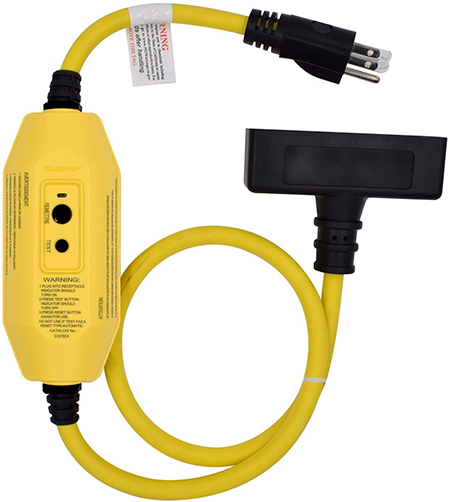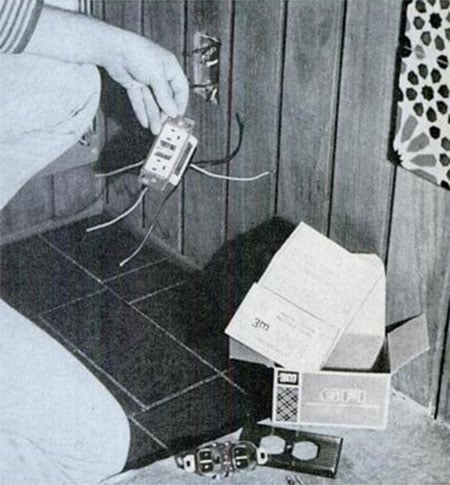
You’ve seen them around your house, usually in your bathroom and kitchen or outside.
They’re electrical outlets with a “test” and “reset” button on them. Maybe you’ve had to press the “reset” button every now and then on one when it seemed to randomly stop working.
Those outlets with the buttons are called GFCI outlets. GFCI stands for “ground fault circuit interrupter.”
GFCI outlets serve a vital function: protecting you from dying from an electrical shock.
If you’ve ever wondered how those “outlets with the buttons on them” work, read on. Below you’ll find the primer on the GFCI outlet you didn’t know you needed.
Understanding Ground Faults
To understand how a GFCI outlet works, it helps to have a rudimentary understanding of how an outlet works in general. So let’s start off with a very elementary outline of how electrical outlets function. (Note: the outlets we’ll be focusing on here are the outlets you’ll find in North America. Other countries have other setups).

Take a look at an outlet. You’re probably very familiar with its configuration of two vertical slots and a hole. But do you know anything about these openings? Let’s zoom in a bit more:
Hot wire slot. The slot on the right is shorter than the slot on the left. The right slot is connected to the “hot wire.” This is where your electricity leaves the outlet to power your devices.
Neutral wire slot. The long slot on the left is connected to the neutral wire. Electricity leaves the hot wire slot, travels to power your device, and then travels back to the neutral wire slot, thus making an electrical circuit.
Ground wire hole. The hole on the bottom goes to your ground wire. Usually, there’s no electricity flowing through the ground wire. Electricity will only flow through the ground wire if there’s a breakdown in how the hot and neutral wires typically carry the electrical current.
In a normal situation, when you plug an electric razor into your outlet near the sink, 120 volts of electricity leave the hot wire to power your device. A neutral wire from your razor takes 120 volts of electric current back to the neutral wire slot on your outlet.
A nice electrical circuit is formed, powering your razor and keeping you safe from electric shock.
But what happens if you drop your electric razor into a sink full of water?
Well, water is a fantastic conductor of electricity thanks to the ions in it from dissolved minerals and salts.
Instead of the electricity flowing back through the neutral wire to the neutral slot on your outlet, the electricity will flow through the water until it gets to the ground.
When the current of electricity strays from a planned path to the ground, it’s called a ground fault.
You can probably see why ground faults could be potentially dangerous. If you were to pick up that electric razor from the sink full of water, you’re picking up a device that no longer has a safe, complete circuit between hot and neutral. The water is now carrying an electrical current. You grab that thing out of the sink, and — POW! — you’re going to get a shock that will send you to kingdom come.
How GFCIs Work
GFCI outlets can detect ground faults and quickly shut off the power from the outlet, potentially saving you from getting electrocuted.
GFCI outlets constantly monitor the electricity leaving the hot wire slot and returning back through the neutral wire slot. In a properly functioning outlet, 120 volts should leave the hot wire, and 120 volts should return to the neutral wire.
If the GFCI outlet senses a mismatch as small as 4 to 5 milliamps between the hot and neutral wire, it interprets this as a potential ground fault, and the GFCI outlet will shut the power off from the outlet immediately (we’re talking in as little as 1/30th of a second).
By shutting off the power on the outlet, GFCIs can significantly reduce the chances of electrocution. In fact, before GFCI outlets were standard in homes, there were an average of 800 deaths by electrocution a year in the United States. Now that GFCI outlets are part of the housing code in American homes, there are less than 200 deaths by electrocution each year.
Where You’ll Find GFCI Outlets
Housing codes in America require that outlets that are placed within 6 feet of a sink or water source are of the GFCI variety. So you usually find GFCI outlets in bathrooms and kitchens. You’ll also find them outdoors since those outlets are potentially exposed to water in the form of rain or snow. Many states also require that GFCI outlets be used in garages and unfinished basements.
Multiple Outlets Can Be Connected to a Single GFCI Outlet
You might have noticed that a non-GFCI outlet in your home will lose power if a nearby GFCI outlet is tripped by a ground fault.
That’s by design. You can wire your outlets so that if a GFCI outlet is flipped off, non-GFCI outlets downstream from the GFCI outlet will also lose power. It’s just a way to provide GFCI protection to you, even on non-GFCI outlets.
Knowing that nearby non-GFCI outlets lose power when a GFCI outlet is tripped can come in handy when troubleshooting a faulty outlet. Often the only thing you need to do to get a non-GFCI outlet working again, is to reset the GFCI outlet that’s nearby.
Another Way to Get GFCI Protection

Besides having GFCI protection on an outlet, you can also buy extension cords that have the same safeguard. You can plug the extension cord into an outlet without GFCI protection and immediately get GFCI protection to the device or appliance you’re using. Lots of contractors use GFCI extension cords to get GFCI protection when there isn’t a GFCI outlet nearby.
You can also install GFCI breakers in your home’s breaker box. This will allow you to provide GFCI protection to all the outlets in an entire room. Usually, GFCI protection is only needed on specific outlets, so GFCI breakers aren’t used that often.
What to Do When Your GFCI Outlet Is Tripped

If your GFCI outlet detects a ground fault and flips off, bringing power back to the outlet is as easy as hitting its “reset” button.
Before you push the reset button, make sure to resolve any issues potentially causing the ground fault. For example, if you dropped your electric razor in a sink full of water, unplug your razor, dry it off, reset the GFCI outlet, and then plug your razor back into the outlet.
How and When to Test Your GFCI Outlets
I bet you didn’t know this: you’re supposed to test ALL of your GFCI outlets every month. It even says so on the outlet.
This is to ensure that your GFCI outlets work when you really need them. Because here’s a scary thing: it’s possible for your GFCI outlet to continue giving power but not be able to detect a ground fault. That means when a ground fault occurs, instead of shutting off the power from the outlet, your GFCI outlet will continue to spit out power, potentially electrocuting you to death.
So test your GFCI outlets.
Thankfully, it’s pretty dang easy to do:
Simply plug an electronic device, like a hair dryer, into your GFCI outlet. Turn it on.
Push the “test” button on your GFCI outlet. The power from the outlet will shut off, and the hair dryer should too.
Press the “reset” button on your GFCI outlet. The power from the outlet will come back on, and the hair dyer should resume working as well.
Bam! You tested your GFCI outlet.
There you go. Now you know how that thing you’ve glanced at thousands of times while brushing your teeth actually works.







